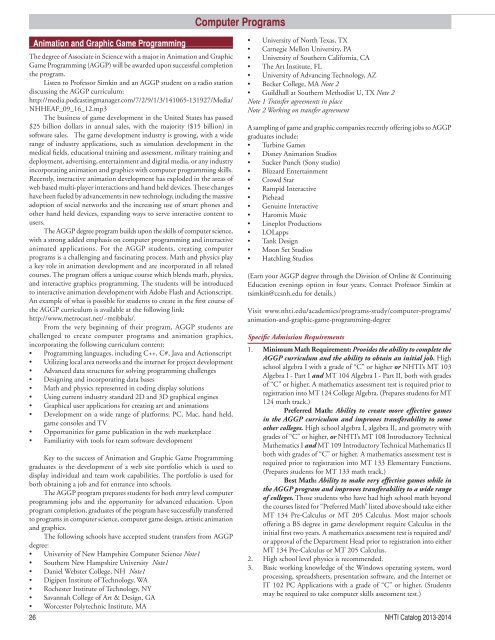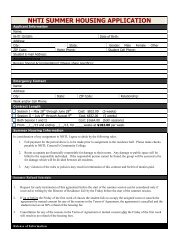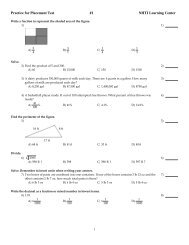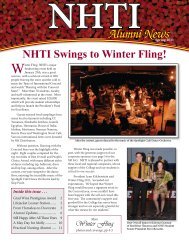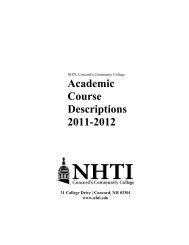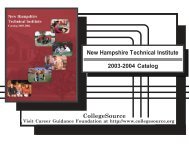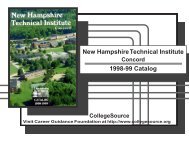NHTI, Concord's Community College Catalog 2013-2014
NHTI, Concord's Community College Catalog 2013-2014
NHTI, Concord's Community College Catalog 2013-2014
You also want an ePaper? Increase the reach of your titles
YUMPU automatically turns print PDFs into web optimized ePapers that Google loves.
Animation and Graphic Game Programming<br />
The degree of Associate in Science with a major in Animation and Graphic<br />
Game Programming (AGGP) will be awarded upon successful completion<br />
the program.<br />
Listen to Professor Simkin and an AGGP student on a radio station<br />
discussing the AGGP curriculum:<br />
http://media.podcastingmanager.com/7/2/9/1/3/141065-131927/Media/<br />
NHHEAF_09_16_12.mp3<br />
The business of game development in the United States has passed<br />
$25 billion dollars in annual sales, with the majority ($15 billion) in<br />
software sales. The game development industry is growing, with a wide<br />
range of industry applications, such as simulation development in the<br />
medical fields, educational training and assessment, military training and<br />
deployment, advertising, entertainment and digital media, or any industry<br />
incorporating animation and graphics with computer programming skills.<br />
Recently, interactive animation development has exploded in the areas of<br />
web based multi-player interactions and hand held devices. These changes<br />
have been fueled by advancements in new technology, including the massive<br />
adoption of social networks and the increasing use of smart phones and<br />
other hand held devices, expanding ways to serve interactive content to<br />
users.<br />
The AGGP degree program builds upon the skills of computer science,<br />
with a strong added emphasis on computer programming and interactive<br />
animated applications. For the AGGP students, creating computer<br />
programs is a challenging and fascinating process. Math and physics play<br />
a key role in animation development and are incorporated in all related<br />
courses. The program offers a unique course which blends math, physics,<br />
and interactive graphics programming. The students will be introduced<br />
to interactive animation development with Adobe Flash and Actionscript.<br />
An example of what is possible for students to create in the first course of<br />
the AGGP curriculum is available at the following link:<br />
http://www.metrocast.net/~mtibbals/.<br />
From the very beginning of their program, AGGP students are<br />
challenged to create computer programs and animation graphics,<br />
incorporating the following curriculum content:<br />
• Programming languages, including C++, C#, Java and Actionscript<br />
• Utilizing local area networks and the internet for project development<br />
• Advanced data structures for solving programming challenges<br />
• Designing and incorporating data bases<br />
• Math and physics represented in coding display solutions<br />
• Using current industry standard 2D and 3D graphical engines<br />
• Graphical user applications for creating art and animations<br />
• Development on a wide range of platforms; PC, Mac, hand held,<br />
game consoles and TV<br />
• Opportunities for game publication in the web marketplace<br />
• Familiarity with tools for team software development<br />
Key to the success of Animation and Graphic Game Programming<br />
graduates is the development of a web site portfolio which is used to<br />
display individual and team work capabilities. The portfolio is used for<br />
both obtaining a job and for entrance into schools.<br />
The AGGP program prepares students for both entry level computer<br />
programming jobs and the opportunity for advanced education. Upon<br />
program completion, graduates of the program have successfully transferred<br />
to programs in computer science, computer game design, artistic animation<br />
and graphics.<br />
The following schools have accepted student transfers from AGGP<br />
degree:<br />
• University of New Hampshire Computer Science Note1<br />
• Southern New Hampshire University Note1<br />
• Daniel Webster <strong>College</strong>, NH Note1<br />
• Digipen Institute of Technology, WA<br />
• Rochester Institute of Technology, NY<br />
• Savannah <strong>College</strong> of Art & Design, GA<br />
• Worcester Polytechnic Institute, MA<br />
Computer Programs<br />
• University of North Texas, TX<br />
• Carnegie Mellon University, PA<br />
• University of Southern California, CA<br />
• The Art Institute, FL<br />
• University of Advancing Technology, AZ<br />
• Becker <strong>College</strong>, MA Note 2<br />
• Guildhall at Southern Methodist U, TX Note 2<br />
Note 1 Transfer agreements in place<br />
Note 2 Working on transfer agreement<br />
A sampling of game and graphic companies recently offering jobs to AGGP<br />
graduates include:<br />
• Turbine Games<br />
• Disney Animation Studios<br />
• Sucker Punch (Sony studio)<br />
• Blizzard Entertainment<br />
• Crowd Star<br />
• Rampid Interactive<br />
• Piehead<br />
• Genuine Interactive<br />
• Haromix Music<br />
• Lineplot Productions<br />
• LOLapps<br />
• Tank Design<br />
• Moon Set Studios<br />
• Hatchling Studios<br />
(Earn your AGGP degree through the Division of Online & Continuing<br />
Education evenings option in four years. Contact Professor Simkin at<br />
tsimkin@ccsnh.edu for details.)<br />
Visit www.nhti.edu/academics/programs-study/computer-programs/<br />
animation-and-graphic-game-programming-degree<br />
Specific Admission Requirements<br />
1. Minimum Math Requirement: Provides the ability to complete the<br />
AGGP curriculum and the ability to obtain an initial job. High<br />
school algebra I with a grade of “C” or higher or <strong>NHTI</strong>’s MT 103<br />
Algebra I - Part I and MT 104 Algebra I - Part II, both with grades<br />
of “C” or higher. A mathematics assessment test is required prior to<br />
registration into MT 124 <strong>College</strong> Algebra. (Prepares students for MT<br />
124 math track.)<br />
Preferred Math: Ability to create more effective games<br />
in the AGGP curriculum and improves transferability to some<br />
other colleges. High school algebra I, algebra II, and geometry with<br />
grades of “C” or higher, or <strong>NHTI</strong>’s MT 108 Introductory Technical<br />
Mathematics I and MT 109 Introductory Technical Mathematics II<br />
both with grades of “C” or higher. A mathematics assessment test is<br />
required prior to registration into MT 133 Elementary Functions.<br />
(Prepares students for MT 133 math track.)<br />
Best Math: Ability to make very effective games while in<br />
the AGGP program and improves transferability to a wide range<br />
of colleges. Those students who have had high school math beyond<br />
the courses listed for “Preferred Math” listed above should take either<br />
MT 134 Pre-Calculus or MT 205 Calculus. Most major schools<br />
offering a BS degree in game development require Calculus in the<br />
initial first two years. A mathematics assessment test is required and/<br />
or approval of the Department Head prior to registration into either<br />
MT 134 Pre-Calculus or MT 205 Calculus.<br />
2. High school level physics is recommended.<br />
3. Basic working knowledge of the Windows operating system, word<br />
processing, spreadsheets, presentation software, and the Internet or<br />
IT 102 PC Applications with a grade of “C” or higher. (Students<br />
may be required to take computer skills assessment test.)<br />
26 <strong>NHTI</strong> <strong>Catalog</strong> <strong>2013</strong>-<strong>2014</strong>


